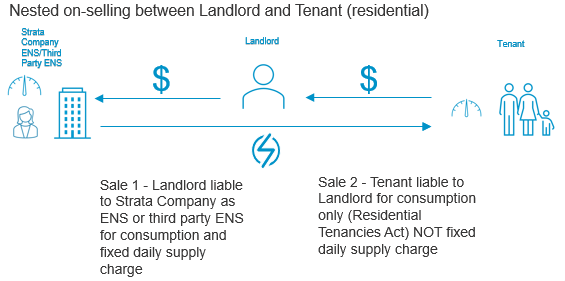Residential
Some lot owners rent apartments or similar within the embedded network to residential tenants. The lot owner (landlord) is charged for electricity (both consumption and fixed daily supply charge) by the embedded network seller (ENS), who may be the strata company or a third party. The landlord passes on the electricity consumption charge only to the tenant under the terms of a residential tenancy agreement.
The Residential Tenancies Act 1987 provides that the landlord is not permitted to pass on the fixed supply charge from the ENS to its tenant/s.
This scenario is referred to as nested on-selling, where two sales of electricity occur:
- Sale 1 – between the ENS and landlord
- Sale 2 – between the landlord and its tenant
Note: If the tenant has an electricity supply contract directly with the ENS, it is not nested on-selling.
Nevertheless, if:
- the ENS is the landlord; and
- electricity is charged pursuant to a tenancy agreement subject to the Residential Tenancies Act 1987;
the landlord is still not permitted to pass on the fixed supply charge to its tenant (under the terms of the Residential Tenancies Act 1987).
Non-residential
Nested on-selling may also occur in a non-residential (or mixed use) embedded network, if a strata‑titled unit is owned as an investment property and leased to a commercial tenant.
However, the Residential Tenancies Act 1987 does not apply to these electricity supply arrangements and a non-residential tenant may be levied with a daily supply charge by its landlord.





